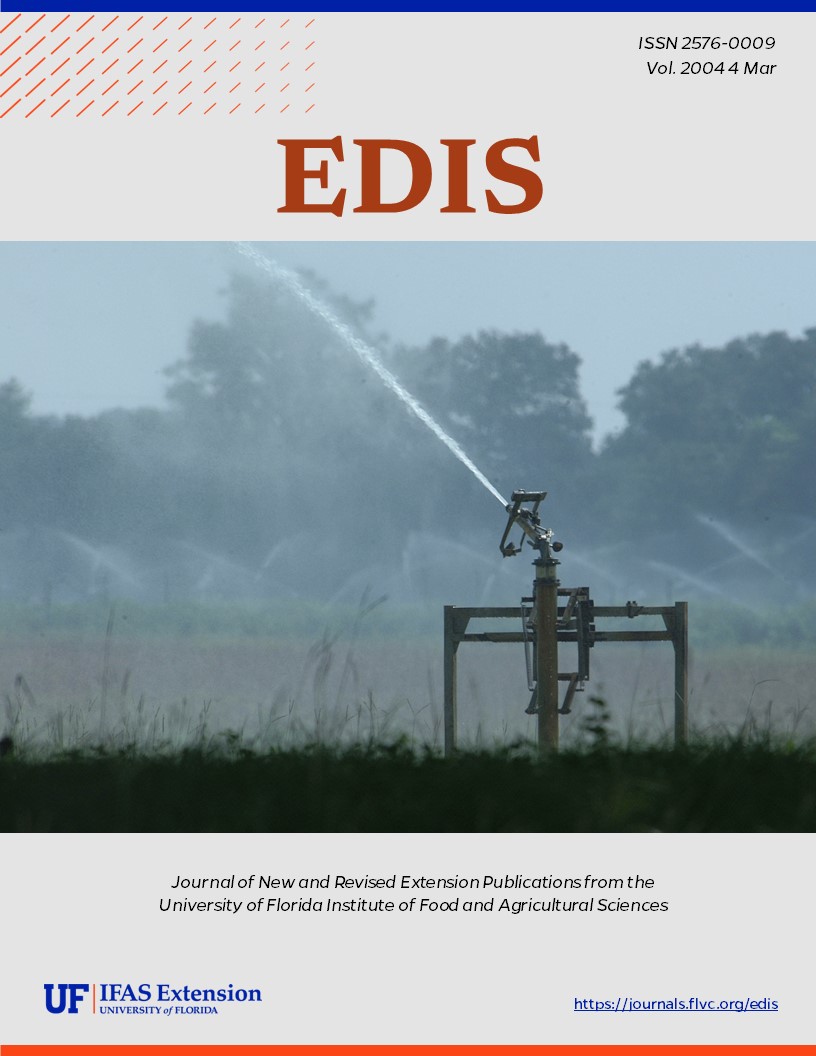Abstract
Aside from water clarity, the color of water in a lake is one of the main attributes that captures people's attention—particularly if the color begins to change. As this circular explains, changes in color can affect the biological productivity of a waterbody including the abundance of aquatic plants and/or algae. However, readers will also learn that most of these changes are the result of natural processes that occur within the watershed. Related topics of discussion include apparent color, true color, suspended and dissolved substances, along with the dynamics of light refraction. The last section provides two empirical models (equations) that can be used to determine if color in a waterbody is the result of algae or suspended solids. This document, CIR108, is the eighth of a series of information circulars dedicated to familiarizing citizens with the language and techniques used by those involved in water management. © January 2004, 1st Edition.
Cir108/FA105: A Beginners Guide to Water Management?Color (ufl.edu)
References
Hutchinson, G. E. 1957. A Treatise on Limnology. Volume I. Geography, Physics and Chemistry. John Wiley & Sons, Inc., New York, New York.
Florida LAKEWATCH. 1999. A Beginner's Guide to Water Management - The ABCs / Descriptions of Commonly Used Terms. Information Circular #101. Florida LAKEWATCH, Department of Fisheries and Aquatic Sciences, University of Florida/Institute of Food and Agricultural Sciences (UF/IFAS), Gainesville, Florida.
Florida LAKEWATCH. 2000. A Beginner's Guide to Water Management - Nutrients. Information Circular #102. Florida LAKEWATCH, Department of Fisheries and Aquatic Sciences, University of Florida/Institute of Food and Agricultural Sciences (UF/IFAS), Gainesville, Florida.
Florida LAKEWATCH. 2000. A Beginner's Guide to Water Management - Water Clarity. Information Circular #103. Florida LAKEWATCH, Department of Fisheries and Aquatic Sciences, University of Florida/Institute of Food and Agricultural Sciences (UF/IFAS), Gainesville, Florida.
Wetzel, R. G. 1975. Limnology. W. B. Saunders Company. Philadelphia, Pennsylvania.
Roger W. Bachmann, Christine A. Horsburgh, Mark V. Hoyer, Laura K. Mataraza, and Daniel E. Canfield, Jr. 2002. Relations between trophic state indicators and plant biomass in Florida lakes. Hydrobiologia 470: 219-234. https://doi.org/10.1023/A:1015660922494
Brezonik, P.I. 1978. Effect of organic color and turbidity on Secchi disc transparency. Journal of the Fisheries Research Board of Canada 35:1410-1416. https://doi.org/10.1139/f78-222
Brown, Claude D., Mark V. Hoyer, Roger W. Bachmann, and Daniel E. Canfield, Jr. 2000. Nutrient-chlorophyll relationships: an evaluation of empirical nutrient-chlorophyll models using Florida and north-temperate lake data. Canadian Journal of Fisheries and Aquatic Sciences. 57(8): 1574-1583. https://doi.org/10.1139/f00-090
Canfield, D. E., Jr. and L. M. Hodgson. 1983. Prediction of Secchi disc depths in Florida lakes: impact of algal biomass and organic color. Hydrobiologia 99: 51-60. https://doi.org/10.1007/BF00013717
Canfield, D. E., Jr., S. B. Linda and L. M. Hodgson. 1984. Relations between color and some limnological charac teristics of Florida lakes. Water Resources Bulletin 20: 323-329. https://doi.org/10.1111/j.1752-1688.1984.tb04711.x
For information about the earth's electromagnetic spectrum: http://imagine.gsfc.nasa.gov/docs/science/know_l1/emspectrum.html
For information about plant management in Florida waters: http://plants.ifas.ufl.edu/guide/
Unless otherwise specified, articles published in the EDIS journal after January 1, 2024 are licensed under a Creative Commons Attribution-NonCommercial-NoDerivs 4.0 International (CC BY-NC-ND 4.0) license.

